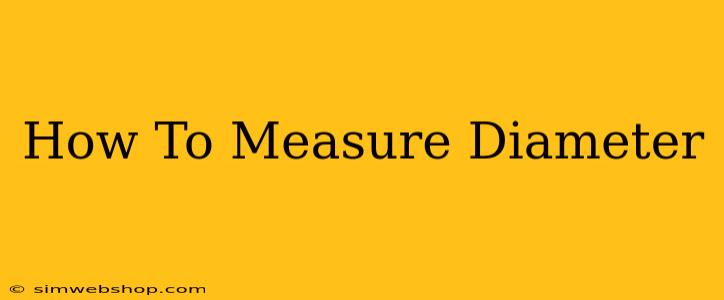Measuring diameter might seem straightforward, but achieving accurate results requires understanding the right tools and techniques for different objects. This comprehensive guide will walk you through various methods, ensuring you master this fundamental measurement.
Understanding Diameter
Before diving into the methods, let's clarify what diameter means. The diameter of a circle or sphere is the straight line passing through the center that connects two points on the opposite edges. It's essentially the longest distance across the circular object. This definition is crucial for selecting the appropriate measurement technique.
Tools for Measuring Diameter
The best tool for measuring diameter depends on the object's size, shape, and material. Here are some common tools:
1. Ruler or Tape Measure:
- Best for: Measuring relatively large and flat circular objects like plates, lids, or wheels.
- How to use: Carefully place the ruler across the widest part of the circle, ensuring the ruler's edge passes through the center. Read the measurement where the ruler intersects the opposite edge. For irregular shapes, use calipers (explained below).
2. Calipers:
- Best for: Measuring precise diameters of smaller objects or objects with irregular surfaces. Vernier calipers offer even greater precision.
- How to use: Open the calipers and gently place the jaws around the object, ensuring a snug fit. Read the measurement displayed on the caliper's scale. Different types of calipers (digital, vernier, dial) have slightly different reading methods.
3. Micrometer:
- Best for: Extremely precise diameter measurements of very small objects. Offers the highest level of accuracy.
- How to use: Micrometers are more complex tools and require proper training for accurate use. They are typically used in precision engineering and manufacturing settings.
4. Diameter Measuring Wheel:
- Best for: Measuring large diameters, such as those of trees or pipes.
- How to use: Simply roll the wheel around the circumference of the object, and the wheel will automatically calculate the diameter.
Measuring Diameter of Different Objects
The method you choose will depend on the object's characteristics:
Measuring the Diameter of a Circle
For a perfect circle drawn on paper, using a ruler is sufficient. Place the ruler across the circle, ensuring it passes through the center. For imperfect circles or irregular shapes, calipers are recommended.
Measuring the Diameter of a Sphere
Spheres present a slight challenge. You can use calipers to measure the diameter across the widest part. If the sphere is large, a tape measure is a viable alternative, making sure to measure the widest part of the sphere to ensure an accurate diameter reading.
Measuring the Diameter of Irregular Objects
For irregularly shaped objects, calipers are the preferred tool, enabling accurate measurement across the widest dimension.
Tips for Accurate Diameter Measurement
- Multiple Measurements: Take several measurements at different points on the circle and average them to account for minor imperfections or irregularities.
- Proper Tool Selection: Choose the tool that best suits the object's size and the level of accuracy required.
- Clean Tools: Ensure your tools are clean and free of debris before you begin measuring.
- Careful Placement: Ensure your measuring tool is positioned correctly and securely.
Conclusion: Mastering Diameter Measurement
Accurate diameter measurement is essential in various fields, from engineering and manufacturing to woodworking and construction. By understanding the different tools and techniques, and following the tips above, you can confidently and precisely measure the diameter of any object. Remember to always choose the most appropriate tool for the task and take multiple measurements for greater accuracy.

